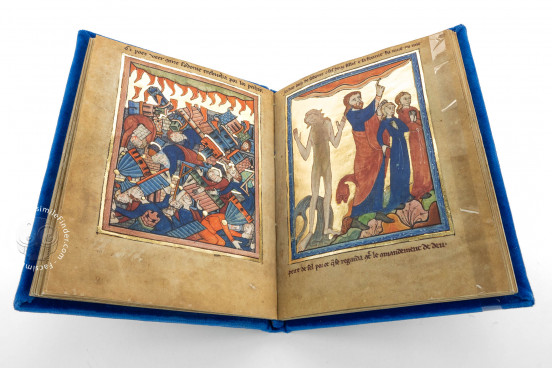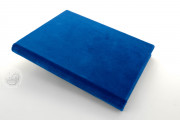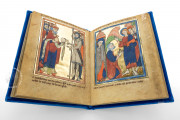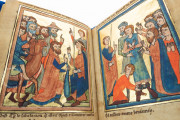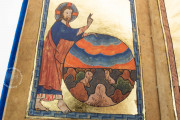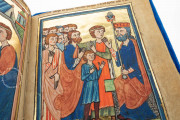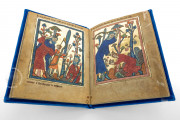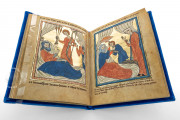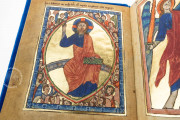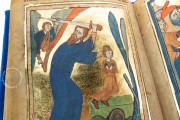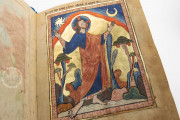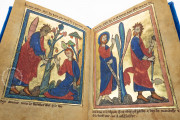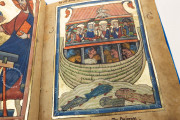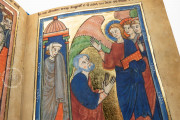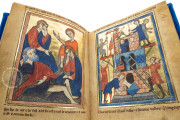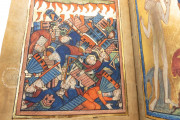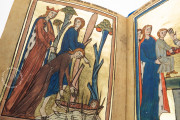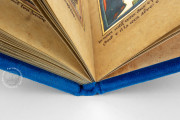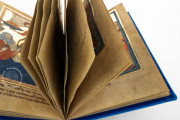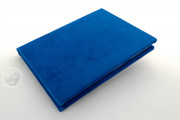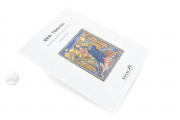A rare and unusual manuscript type, the Picture Bible of the John Rylands Library is a sumptuous example of the early Gothic "Channel" style. Composed of forty-eight parchment folios, each contains a full-page composition illustrating a single biblical scene beginning with the Creation and ending with the Marriage of Moses. Eight pages are missing from the sequence of an original fifty-six images, which were originally painted in pairs. These were certainly the beginning of a longer work, likely a Picture Bible which would have included parts of the New Testament. The background of each scene is burnished gold denoting that the depicted narrative exists in sacred time. French captions running above and below each framed miniature describe the narrative taking place.
The original owner of the manuscript is unknown, however, the lavish amount of gold and bright pigments coupled with the layout using only one side of each folio suggests a wealthy patron who took delight in biblical stories and preferred large pictures of the characters and scenes over the actual text. Picture Bibles are a rare type of book that appeared in the early Gothic period in northern France and exemplify the evolving primacy of image over text in high- and late-medieval Europe.
The Rare Picture Bibles of Gothic France
Picture Bibles were made in northeast France around the beginning of the thirteenth century. In these works, the biblical text is reduced to captions while illustrations of narrative scenes fill much or all of the page. In these works, the images were executed first and the captions added last, sometimes years later.
Often, multiple scenes, usually four, are arranged on each page allowing for a greater number of illustrations. The Rylands Library example is unusual in its single image per page layout. Other examples include the Morgan Bible Picture Book, the Huth Bible, and the Hague Bible Picture Book.
Exquisite Full-Page Biblical Illuminations
The Rylands Picture Bible's forty-eight illustrations begin with the Creation cycle and end abruptly with the Marriage of Moses. The compositions are generally simple in design featuring large figures in bright robes against backgrounds of burnished gold.
The book contains little text. The captions run along the top of each frame and continue below, if necessary, and are descriptive of the image they accompany rather than being direct biblical text.
The script is a practiced Gothic littera bastarda, more secretarial than formal, and is written in black ink. It was likely added a few years after the completion of the pictures.
From the Bibliotheca Lindesiana to the John Rylands Library
The Picture Bible of the John Rylands Library was purchased by James Ludovic Lindsay, 26th Earl of Crawford, from the booksellers Ludwig and Jacques Rosenthal of Munich in 1893. It became a volume within the impressive Bibliotheca Lindesiana, which contained approximately six thousand manuscripts. In 1901, Enriqueta Rylands, the widow of John Rylands who established the library in his name, paid £155,000 for the Lindsay library. This manuscript was accessioned that year with the shelfmark French MS 5.
We have 2 facsimiles of the manuscript "Rylands Picture Bible":
- Bibbia Aurea. Il Manoscritto French 5 facsimile edition published by Istituto dell'Enciclopedia Italiana - Treccani, 2022
- Bibbia di Manchester John Rylands Ms. 5 facsimile edition published by Imago, 2019

